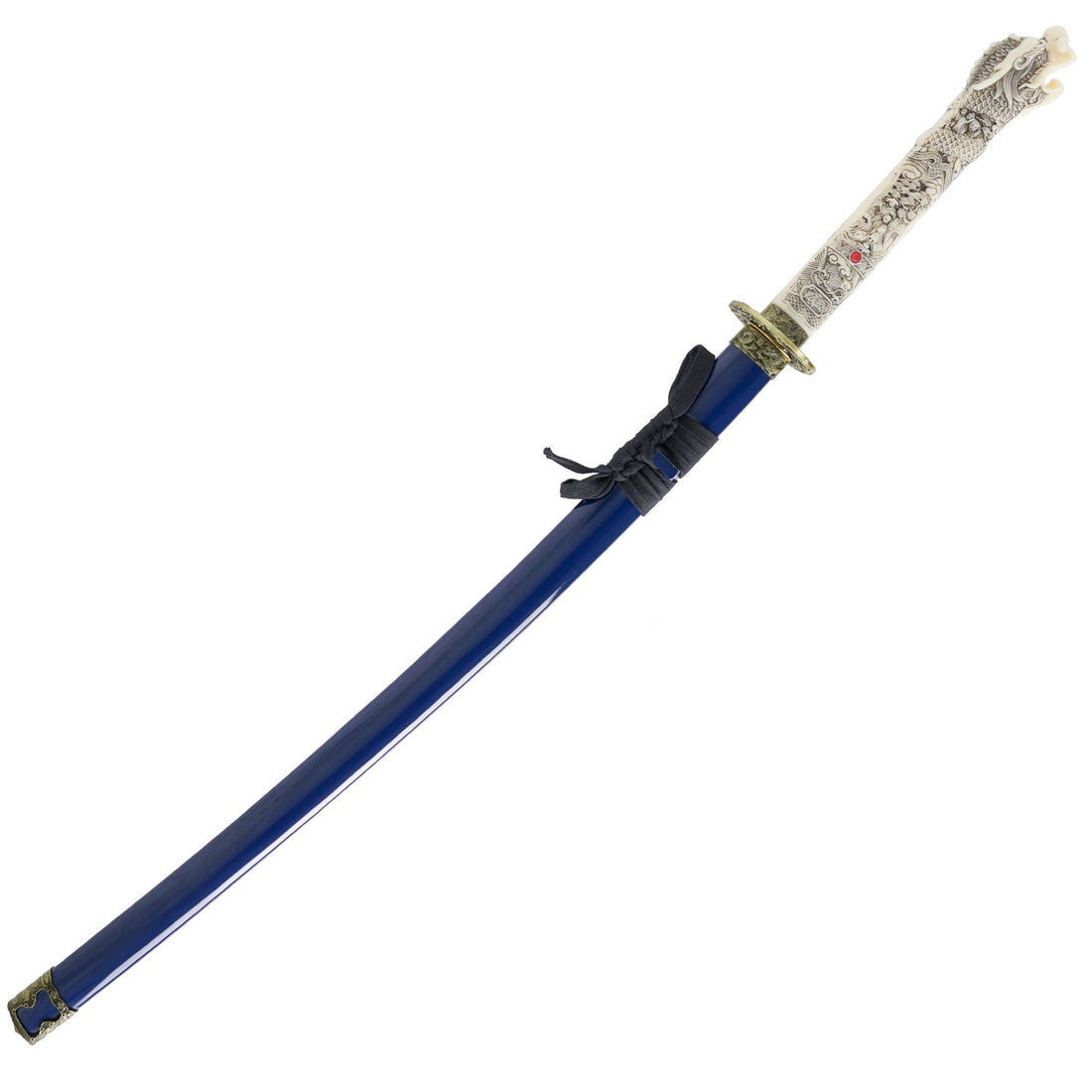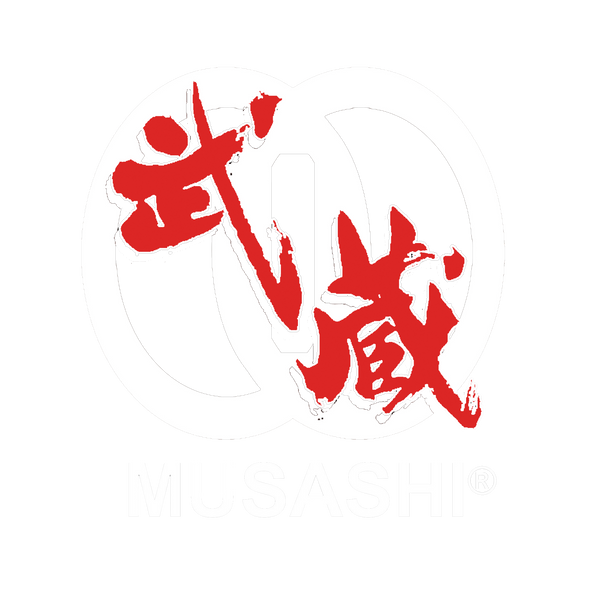
Understanding the Price of Authentic Katanas: What Are You Paying For?
Share
When shopping for a katana, you might experience sticker shock at the wide range of prices – from under $100 to well over $1,000 for production models, and tens of thousands for traditionally crafted pieces. This significant price variation often leaves buyers wondering: what exactly am I paying for? This guide will demystify katana pricing by breaking down the factors that influence cost and help you understand the value behind your investment.
The Foundation: Steel Quality and Forging Methods
The most fundamental element determining a katana’s price is the quality of steel and the forging technique used to create the blade.
Steel Types and Their Impact on Price
According to Musashi Swords’ product information, several steel types are commonly used in modern katanas, each with different characteristics and price points:
- 1045 Carbon Steel: Found in entry-level swords like the Musha collection, this steel offers “reasonable durability at a lower price point.” While functional, it doesn’t hold an edge as well as higher carbon steels. Swords made from this steel typically range from $70-$200.
- 1060 Carbon Steel: Used in Musashi’s Silver Collection, this steel represents “a great compromise between strength and edge hardness.” As they note, “Not only are 1060 carbon steel swords able to hold an edge its primary focus is its durability.” Expect prices between $200-$500 for quality swords using this steel.
- 1095 Carbon Steel: Found in higher-end blades like Musashi’s Gold Collection, this steel is “very hard and must be properly heat treated making its forging process extremely difficult.” The website explains it’s “exceptional at holding its edge” but requires more skill to work with, justifying higher prices typically between $500-$800.
- T10 Steel: Used in premium offerings like Musashi’s Platinum Collection, T10 is “a tungsten alloy steel that has an extremely high carbon content combined with a bit of silicon. This makes for an exceptionally hard blade that is impervious to scratches and abrasions.” These sophisticated blades usually start around $800 and go well beyond $1,000.
- Tamahagane: The most traditional and expensive steel, described by Musashi as “the purest Japanese steel” and “one of the rarest materials used in katana forging.” They explain, “The forging process to create a sword using Tamahagane takes several months to years.” True Tamahagane swords typically cost thousands or even tens of thousands of dollars.
Forging Methods and Their Value
The technique used to forge the blade significantly impacts both performance and price:
- Maru-kitae or Muku-Kitae Method: Used for Musha and Silver Collection swords, this involves forging from a single piece of homogeneous steel. Musashi describes it as “incorporating traditional Muku-Kitae method of forge from a homogenous steel.” This is the most straightforward forging method, resulting in lower production costs.
- Kobuse-Kitae Method: Used in the Gold Collection, this more sophisticated approach “combines two types of steels” to create a blade with both edge-holding ability and flexibility. As Musashi explains, this technique creates “a combination of the best of both worlds; keeping a keen edge while still maintaining its durability.”
- Gomai-Kitae Method: Found in the Platinum Collection, this advanced technique uses “three layers two steels” for premium performance. This labor-intensive process requires significant skill and time, contributing to higher prices.
Each step up in forging complexity adds to the production cost and the resulting price, but also delivers tangible benefits in performance, durability, and aesthetic qualities.
The Details: Components and Fittings
Beyond the blade itself, numerous components affect both the functionality and price of a katana: Musashi® Collection
Tsuka (Handle) Construction
High-quality handles feature: - Genuine ray skin (same) wrapping underneath the handle cord - Proper alternative to ray skin in more affordable models - Tightly wrapped handle cord (ito) with clean, even patterns - Real wooden core properly fitted to the tang
Budget swords often cut corners with synthetic materials, poorly fitted components, or simplified construction. Premium swords, like those in Musashi’s higher-end collections, feature more traditional materials and construction methods that require skilled handwork.
Tsuba (Handguard) and Fittings
The metal fittings on a katana can dramatically affect both aesthetics and price:
- Basic Fittings: Entry-level swords like the Musha line feature simpler designs and less expensive metals. These may still be attractive but lack the fine detailing of premium pieces.
- Mid-Range Fittings: Swords in collections like Musashi’s Silver line offer more detailed designs and better materials.
- Premium Fittings: High-end models feature hand-crafted fittings using traditional designs and techniques. The Musashi Miyamoto Collection showcases this level of craftsmanship, with pieces that are “not only a hand-crafted work of art, but also tell a historical story. Each epic story is delicately hand-engraved throughout the different elements of the swords.”
As Musashi notes about their premium offerings, “These artfully designed swords are hand-crafted using gold, copper, bronze and silver to beautifully create a timeless collectible sword.” Each step up in materials and craftsmanship adds to the final price.
Saya (Scabbard) Quality
The scabbard quality varies significantly across price points:
- Basic Sayas: Found on entry-level swords, these might be made from less expensive woods with painted finishes. The Musha collection offers “standard high gloss finish for a classic look or a choice of colors and designs that are etched, imprinted or hand painted on the saya.”
- Premium Sayas: Higher-end swords feature scabbards made from better quality woods with more sophisticated finishes, often including hand-painted designs or inlays on the highest-priced models.
The Art: Aesthetics and Craftsmanship
As the price of katanas increases, you’re increasingly paying for artistic elements that transform a functional weapon into a work of art:
Hamon (Temper Line)
The hamon is the visible pattern along the blade resulting from differential hardening:
- Machine-Made or Etched Hamon: Less expensive swords often have artificial hamon lines that are etched onto the surface rather than being a result of the actual heat treatment process.
- Real Differential Hardening: Premium swords feature authentic hamon created through traditional clay application and heat treatment. This process requires considerable skill and contributes significantly to higher prices.
The authentic hamon found on higher-priced swords isn’t just decorative—it reflects a blade with a harder edge for cutting and a more flexible spine for durability, exactly what traditional Japanese sword makers sought to achieve.
Polish and Finish Quality
The level of polish dramatically affects both appearance and price: - Entry-level swords receive basic polishing - Mid-range swords feature more refined finishes - Premium swords undergo extensive hand polishing to bring out the steel’s characteristics
As prices increase, more time is spent on bringing out the subtle details of the steel and creating cleaner, more reflective surfaces. The highest-priced production swords may undergo dozens of hours of careful hand-polishing.
Artistic Elements
The most expensive katanas feature artistic elements that require specialized skills:
- Hand-Engraving: Premium pieces like those in Musashi’s Miyamoto Collection feature detailed hand-engraved designs.
- Gold/Silver Inlay: The highest-priced production swords often include precious metal inlays and accents.
- Themed Designs: Collectors often pay premiums for coherent artistic themes. As Musashi describes their premium line: “These swords are not only a hand-crafted work of art, but also tell a historical story.”
Beyond Materials: Brand Reputation and Collection Positioning
Intangible factors also significantly impact pricing:
Brand Prestige and History
Established brands with strong reputations command premium prices. Musashi Swords notes their own reputation: “For decades Musashi® swords have been admired by collectors and awarded in competitions amongst practitioners.”
Reputation-based pricing reflects not just marketing but tangible benefits: consistent quality control, better customer service, and the assurance that your sword meets certain standards. As Musashi states, “The Musashi® Collection truly represents the skill, honor and strength of the ancient samurai.”
Collection Positioning
Most manufacturers offer tiered collections at different price points:
|
Musashi Collection |
Steel Type |
Forging Method |
Price Range |
|
Musha (Entry-Level) |
1045 Carbon Steel |
Maru-kitae |
$70-$200 |
|
Silver (Mid-Range) |
1060 Carbon Steel |
Muku-Kitae |
$200-$500 |
|
Gold (Premium) |
1060/1095/Damascus |
Kobuse-Kitae |
$500-$800 |
|
Platinum (Elite) |
T10/Tamahagane |
Kobuse/Gomai-Kitae |
$800+ |
|
Miyamoto (Collector) |
Various Premium |
Various |
$1,000+ |
Higher tiers represent not just better materials but different target markets. As you move up Musashi’s collection tiers, you’re transitioning from functional training tools to art pieces worthy of collection and display.
Special Cases: Traditional Craft vs. Production Swords
It’s important to understand the vast price difference between modern production swords and traditionally crafted Japanese swords:
Production Swords
Even high-end production swords from companies like Musashi utilize some modern methods and materials to create quality blades at relatively accessible prices (typically under $2,000). These represent excellent value for practitioners and collectors but aren’t made using fully traditional methods.
Traditionally Crafted Nihonto
True traditionally crafted Japanese swords (nihonto) made by licensed Japanese swordsmiths (tosho) using ancient techniques typically start at $10,000 and can exceed $50,000. These prices reflect: - Years of apprenticeship and training - Months of work on a single blade - Traditional materials and processes - Cultural and historical significance - Artistic merit beyond functionality
Making an Informed Purchase Decision
With this understanding of pricing factors, how do you decide what’s worth paying for?
Matching Price to Purpose
Consider your primary reasons for buying a katana:
- For Display Only: If you’re primarily interested in aesthetic appeal, you might prioritize appearance over performance characteristics. A mid-range sword with attractive fittings might be the sweet spot.
- For Martial Arts Practice: Practitioners need functional, durable swords with good balance and safe construction. The Musashi Silver Collection or higher would provide the durability needed for regular training.
- For Cutting Practice: Those focusing on cutting techniques (tameshigiri) need properly hardened blades with good edge retention. The Gold Collection’s 1095 steel swords would be appropriate for serious cutting practice.
- For Collection: Collectors often value historical accuracy, artistic merit, and craftsmanship details that justify premium prices. The Miyamoto or Platinum Collections would appeal to this group.
Value Sweet Spots
Based on the Musashi product tiers, these price ranges typically offer good value:
- $150-$300: The upper end of the Musha range offers good functional swords for beginners. Musashi notes these are appropriate “for collections, gifts, or straw mat cutting practice.”
- $300-$600: The Silver Collection represents a significant step up in materials and performance without reaching premium prices. This range offers what Musashi describes as “a great compromise between strength and edge hardness.”
- $600-$1,000: The Gold Collection offers premium features and materials at the top end of production sword pricing. These swords “combine a beautifully designed work of art with a skillfully sharp sword edge.”
- $1,000+: The Platinum and Miyamoto Collections represent the pinnacle of production swords, approaching traditional craftsmanship in quality and artistry.
Conclusion
The price of an authentic katana reflects a complex interplay of materials, craftsmanship, artistic merit, and brand positioning. From the 1045 carbon steel of entry-level Musha swords to the rare Tamahagane steel of the highest-end Platinum Collection, each price point offers different benefits and targets different user needs.
Understanding these factors allows you to make informed decisions about what aspects matter most for your purposes. Whether you’re drawn to the accessible quality of Musashi’s Silver Collection, the performance-oriented Gold Collection, or the collector-worthy Platinum and Miyamoto lines, knowing what you’re paying for ensures you’ll appreciate the value of your investment.
Remember that while price often correlates with quality, the “best” sword isn’t necessarily the most expensive one—it’s the one that best matches your specific needs, preferences, and budget. By focusing on the aspects most important to you, you can find excellent value at any price point within the spectrum of authentic katanas.
